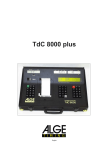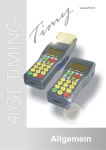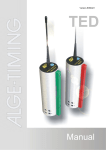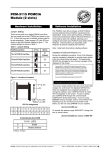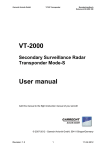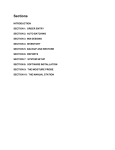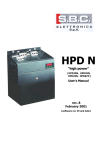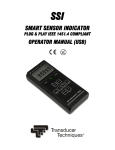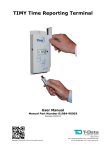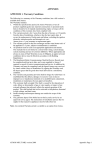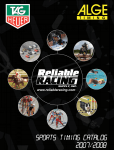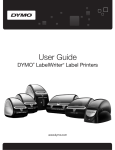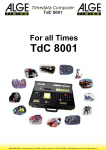Download timy-general-be - Split Second Timing / ALGE Australia
Transcript
Timy English Timy Control Elements 1 ..... USB Interface 2 ..... Charger Socket 3 ..... ALGE MultiPort 4 ..... Connection for Display Board 5 ..... Connection for Start Impulse Device (c0) 6 ..... Connection for Finish Impulse Device (c1) 7 ..... Standard ALGE-Lichtschrankenbuchse Version: E-2004-11-09 Page 2 Timy Version: E-2004-11-09 Page 3 Timy Table of Contents 1. Device Discribtion .................................................................................................................... 6 1.1. Timy Models ............................................................................................................................ 6 1.2. Timy Software .......................................................................................................................... 7 1.3. Keyboard ................................................................................................................................ 8 2. Operating ................................................................................................................................. 9 2.1. Switching Timy on or off ......................................................................................................... 9 2.1.1. Switching on ........................................................................................................................ 9 2.1.2. Switching off ........................................................................................................................ 9 2.2. Select the Language .............................................................................................................. 9 2.3. Power Supply ....................................................................................................................... 10 2.3.1. External Supply ................................................................................................................. 10 2.3.2. Internal Supply .................................................................................................................. 11 2.4. Printer .................................................................................................................................. 13 2.5. Connection with External Devices ........................................................................................ 14 2.6. Timig Channels .................................................................................................................... 16 2.6.1. Delay Times and Block Times ........................................................................................... 16 2.6.1.1. Delay Time ..................................................................................................................... 16 2.6.1.2. Block Time ..................................................................................................................... 16 2.6.1.3. Schematic Presentation of the Delay Time and Block Time ........................................... 16 2.7. Timy-Update ......................................................................................................................... 17 2.8. New Software registration .................................................................................................... 20 2.9. Memory ................................................................................................................................ 21 2.10. Info-Mode ............................................................................................................................. 21 2.11. Synchronisation ................................................................................................................... 21 2.12. Menu-Adjustments ............................................................................................................... 22 3. Programs ............................................................................................................................... 25 4. Accessory .............................................................................................................................. 26 5. Technical Data ........................................................................................................................ 27 5.1. Connection System .............................................................................................................. 28 5.2. Interfaces ............................................................................................................................. 30 5.2.1. RS 232 Interface ............................................................................................................... 30 5.2.2. RS 485 Interface ............................................................................................................... 34 5.2.3. Interface for Display Board ................................................................................................ 34 5.2.4. USB-Interface ................................................................................................................... 34 Technical modifications remain reserved in sense of improvement! ALGE Timy manual copyright by: Version: E-2004-11-09 ALGE-Timing GmbH & Co Rotkreuzstraße 39 A-6890 Lustenau www.alge-timing.com Page 4 Timy Version: E-2004-11-09 Page 5 Timy 1. The ALGE its class. Device Discribtion is a handy device, fully loaded with high-quality technology. This makes it unique in During the evolution, highest attention to the operating convenience and the ergonomic was placed. The old ALGE values, as highest reliability and robust design, also entered besides in the Timy. Newest technology was packed in a special designed case made for timing only, which makes the Timy unique. In spite of the bulk measurement, the Timy owns a big and well operable silicone keyboard. In any weather condition, even with gloves, one can operate the keyboard easily. In the case of the types Timy P and Timy PXE a printer is integrated in the Timy and records the entire race. Of course the Timy is also equipped with the necessary interfaces for communication with external devices. It has a interface for display boards, a RS 232 interface for communication with a PC, a RS 485 interface to make a network of timing devices, and finally as world novelty a future proof USB interface. The memory of the Timy is also gigantic. It can store up to 13.000 times. All memory times can be scrolled on the display, or transmitted to a PC by RS 232 or USB interface. 1.1. Timy Models There are four different models of the Timy available: Timy S: The Timy S is a timer or terminal without printer. It has a standard quartz that does the timing with quartz accuracy. The display works down to about –5°C (23 F) and we do not recommend this model for winter outdoor use. Timy XE: The Timy XE is a timer without printer. It has a temperature compensated quartz oscillator for time measurement with the highest precision and an extended temperature range for operational use down to –20°C (-4 F). Timy P: The Timy P is a timer or terminal with integrated printer. It has a standard quartz that does the timing with quartz accuracy. The display works down to about –5°C (23 F) and we do not recommend this model for winter outdoor use. Timy PXE: The Timy PXE is a timer with integrated printer. It has a temperature compensated quartz oscillator for time measurement with the highest precision and an extended temperature range for operational use down to –20°C (-4 F). Version: E-2004-11-09 Page 6 Timy 1.2. Timy Software It is possible to use different software for the Timy. Every licensed software you can update from the internet. In order to activate software it is necessary to buy it. When you buy the software you will get a user code. This user code you can get at your local ALGE -dealer. At the moment we have not all programs ready. Ask your ALGE dealer for available software. Backup: timer to measure time of day (e.g. backup or reference timer for PC) Stopwatch L: simple timing program total ranking list Stopwatch: universal timing program that is able to time more than one run (net time/total time). Group start and ranking is also possible. LapTimer: timing program that gives you run times and lap times (e.g. for motor sport) TrackTimer: Timing for events with have lanes (e.g. athletic, swimming) PC-Timer: to measure time of day with additional output of the running time in 1/10 seconds through the RS 232 interface. Ideal as precision timer for a PC Training Lite: universal trainings software (many intermediate times are possible) CycleStart: program for track cycling with contdown and lapcounter Commander: terminal to control a display board, but at the moment the program is not complete Version: E-2004-11-09 Page 7 Timy 1.3. Keyboard The Timy has a weather resistant (water proof) silicon keyboard, and is ideal to work outdoor. The keys are big and easy to operate. Function Keys: This keys are used very universal. The function is stated in above in the display. START/ON: With this key you can produce a manual start impulse. Further use this key to switch the Timy on. STOP/OFF: With this key you can produce a manual stop impulse. Further use this key to switch the Timy off. Printer: This key is used for the paper feed (only for model P and PXE). Pressing the key and at the same time, you will reach the printer menu. 2nd: This key you must always use in combination with another key. This allows us to have for each key two functions. Menu: If you press this key you will reach the menu to make all adjustments for the Timy. CLEAR: Key to clear something. Pressing the CLR-key in the timing mode makes the marked time invalid. Otherwise you can e.g. clear the memory. Cursor: Use the cursor keys to move the cursor in the and you will reach the start of a list, display. With with and the end of a list, e.g. time list). Green OK: with this key you can confirm inputs. Mostly the key is used to confirm something that has to do with the start. Further this key is used to confirm the switch on of the Timy. Red OK: with this key you can confirm inputs. Mostly the key is used to confirm something that has to do with the finish. Further this key is used to confirm the switch off of the Timy. Version: E-2004-11-09 Page 8 Timy 2. Operating 2.1. Switching Timy on or off 2.1.1. Switching on • • • • press green key <START/ON> (1) the display shows: „Really switch on? Press green OK“ if you press within 10 seconds the key <OK> (2), than the Timy is activated, otherwise it switches again off 2.1.2. Switching off You have two possibilities to switch the Timy off: Method 1: • press red key <STOP/OFF> (1) for 3 seconds • the display shows:„Really switch off? Press red OK“ • if you press within 10 seconds the red key <OK> (2), than the Timy is switched off, otherwise it continues in the previous program Method 2: • press key <2nd> (1) • press red key <STOP/OFF> (2) for 3 seconds • the display shows: „Really switch off? Press red OK“ • if you press within 10 seconds the red key <OK> (3), than the Timy is switched off, otherwise it continues in the previous program 2.2. Select the Language You can select the operation language of the Timy. At the moment we offer English, Italien, and German. Further languages will follow soon. f the language selection is on "ENGLISH": ISelect in Menu (key ) <GENERAL> and <LANGUAGE> to adjust the language. If the language selection is on "GERMAN": Select in Menu (key ) <ALLGEMEIN> and <SPRACHE> to adjust the language. IIf the language selection is on "ITALIEN": Select in Menu (key Version: E-2004-11-09 ) <GENERALE> and <LINGUA> to adjust the language. Page 9 Timy 2.3. Power Supply The Timy has many possibilities for the power supply: External Supply (+8 to 15 VDC): • Power Supply PS12A (Socket 2 of Timy) • Power Supply PS12 (Socket 7 of Timy) • External Battery (e.g. 12 V Lead-acid accumolator connected to Socket 2 or 7) Internal Power Supply: The Timy has a battery compartment that holds 6 AA-batteries. You can select between different batteries. Timy S Timy XE Timy P Timy PXE below above below above below above below above 5°C 5°C 5°C 5°C 5°C 5°C 5°C 5°C yes yes yes yes no no no no Alkaline Batteries yes yes yes yes no no no no NiCd-Rechargeable no yes no yes no no no no NiMH-Rechargeable yes yes yes yes yes yes yes NC-TIMY Battery Pack yes Timy 2.3.1. External Supply A external supply of the Timy from +8 to +15 VDC is possible. The ALGE PS12A is the ideal external power supply, since it keeps the DIN-socket for the photocell free. Also the ALGE PS12 works with the Timy. It is not allowed to use the NLG8 and NLG4 since the power output is too high and it might destroy the Timy. It the external supply is 11.5 VDC or higher integrated rechargeable batteries will be charged. Power Supply PS12A: Power Supply PS12: External Battery: Version: E-2004-11-09 Page 10 Timy 2.3.2. Internal Supply The Timy P and Timy XE works with different batteries. The Timy P and Timy PXE needs the battery pack NC-TIMY. Timy P or Timy PXE: use only the rechargeable battery pack NC-TIMY (NiCd-rechargeable) Timy S or Timy XE: you can use different typs of batteries (Alkaline, NiMH-Rechargeables, NiCd-Rechargeables, NC-Timy-Battery Block). Version: E-2004-11-09 Page 11 Timy Battery-Types: Alkaline Batteries: This battery type you cannot use for a Timy with a built in printer. Also at cold temperatures Alkaline batteries are not suitable. At –20°C (-4F) there is only a capacity of about 10% left. If you use the Timy very often we also do not recommend this battery, since the costs for new batteries are high and it is cheaper to use rechargeable batteries. Further it is better for the environment to use rechargeable batteries. NiMH- Rechargeable Batteries: This rechargeable battery we recommend for a Timy without printer at temperatures higher than 5°C (41F). At low temperatures the NiCd have more capacity. Never use this battery for a Timy with printer. NiCd-Rechargeable Batteries: This battery we recommend when the Timy is used in cold temperatures below 5°C (41F). Never use this battery for a Timy with printer. NC-Timy: Special designed rechargeable battery block (NiCd) for the Timy. Use only this battery for a Timy with integrated printer. Using any other battery type there may be a low battery warning and the printer may stop to work after printing a few lines. Loading Rechargeable Batteries: You can load the rechargeable battery with the Power Supply PS12A or PS12. During the charging process you have the batteries in the Timy. Charging is also possible during the timing operation (during a race). The charging duration depends on the rechargeable battery type:: • NiCd- Battery with 1 Ah: about 14 hours • NiMH- Battery with 1.5 Ah: about 18 hours If you want to charge the rechargeable batteries faster we can recommend you the table charger LG6AA (this charger you can get at your ALGE-dealer. With this charger you have to take the batteries out of the Timy. It makes it possible to use a set of batteries and charge at the same time another set. Charger-Switch: The Timy has a switch (covered form the battery-sticker). This switch allows you to select, if you have rechargeable batteries or not rechargeable batteries (Alkaline). For Alkaline batteries it is necessary that the charger switch is <ALKALI>. If you load Alkaline batteries they will be destroyed and may leek. The acid may than destroy the complete Timy. When using rechargeable batteries (NiCd or NiMH) you must select the charger-switch position on <NiCd/NiMH>. If you have it on <ALKALI> the batteries will be never loaded when you connect the charging device (e.g. PS12A). Attention: Use no Alkaline batteries in the Timy, if you switch on <NiCd/NiMH) Operating Duration: The operating duration depends on the Timy type, the battery type, and the temperature. Version: E-2004-11-09 Page 12 Timy 2.4. Printer The Timy printer is a thermo printer. It needs special thermo paper. The best printing quality you will have with the original ALGE-paper. This paper you can recognize at the ALGE-Logo on the backside. The printer is very user friendly. The printing head does not move and the printer roll is attached to the printer hood. This means for the change of paper that you have only to open the printer hood, input the new paper, put the paper through the paper opening, and close the paper hood. The printer works fast and silent. With external power supply it prints up to 6 lines per second, when using the internal battery it will still make 4 lines per second. hold yellow printer hood and push it up insert the new paper roll, so that the paper comes out in the front Version: E-2004-11-09 take the emptiy paper roll out, insert the paper axle in the new paper roll feed the paper through the paper opening close the pinter hood and press it with two fingers down Page 13 Timy 2.5. Connection with External Devices Power Supply PS12A or PS12: Push Button 023-02 or 023-10: Startgate STSc: Version: E-2004-11-09 Page 14 Timy Photocell RLS1n: Photocell at the Start with 2-wire Banana Cable: Photocell at the Start with Cable 002-10: Photocell at the Finish with 2-wire Banana Cable: Photocell at the Finish with Cable 001-10: Display Board GAZ4: PC-Connection - RS 232: Version: E-2004-11-09 Page 15 Timy 2.6. Timig Channels The Timy has 9 independent timing channels. Through the RS 485 interface we can extend the channels up to 99. 2.6.1. Delay Times and Block Times the variable delay- and block times make sure that you have a trouble free race, this means that you have no double impulses and do not miss impulses. You can adjust the delay- and block- time in the menu. 2.6.1.1. Delay Time The delay time is the time after the end of an impulse in which the timing device does not take another impulse from the same channel (e.g. a cross country runner could trigger the photocell with both legs – this should be prevented by the delay time). You can adjust the delay times in the menu. The delay time can be sparate adjusted for the start channel c0 and all other channels. Factory Setting: 2.6.1.2. Start Channel c0 = 0,1 s Stop Channel c1 to c9 = 0,1 s Block Time The block time is the theoretical minimum time delay between two valid impulses on the same channel. Impulses within the block time are stored and printed but marked as non valid. The block time is only used in some Timy programs. e.g. for a interval start of 30 seconds the theoretical block time is then about 20 seconds. 2.6.1.3. Schematic Presentation of the Delay Time and Block Time Dt ......timing channel triggers 1 ....... timing channel triggers – valid time goes to memory – block time starts 2 ....... end of the impulse – delay time starts 3 ....... timing channel is triggers during the delay time – no impulse registration 4 ....... end of the timing impulse – delay time starts again 5 ....... timing channel is triggered during the block time – a non valid time goes to the memory 6 ....... end of the impulse – delay time starts 7 ....... timing channel triggers – non valid time goes to the memory – block time starts Version: E-2004-11-09 Page 16 Timy 2.7. Timy-Update It is possible to update the Timy software without any costs from the internet www.alge-timing.com. In case of no internet connection please contact your ALGE representative. It is only possible to update licensed software. To not licensed software (software that you did not buy) you will have no access. In order to have additional software available you need a code. This code you can get from your ALGE -dealer. Update: • Dial into the Internet • Select the ALGE-Homepage under www.alge-timing.com • Select the language, e.g. English • Select the „Download“ section • Select „Software for ALGE-devices with Flash-Technology“ Version: E-2004-11-09 Page 17 Timy • Download the „Install-Manager“, if you do not have this software already. Download it in a folder that is easy to find and open. The file that you download is named „Autorun.exe“. It is only one file and does not need an installation to start it. To start the software just click on „Autorun.exe“. • Download the Timy Flash update (please check the version number, if it is really newer than the existing one) • Download the Timy Flash update into the same folder as the InstallManager. • Start the Windows Explorer • Start the Install-Manager by double clicking on „Autorun.exe“ Version: E-2004-11-09 Page 18 Timy • Select „Firmware“ • Switch the Timy on • Wait until you see the picture of the Timy • Select the folder were you have stored the „timy.exe“ file • Start the update • Give the right path to the downloaded timy file • Start update Version: E-2004-11-09 Page 19 Timy 2.8. New Software registration The are many different programs for the Timy. A lot of software is included when buying the Timy and ready to operate. Other software is only avalable after a registration wiht a code. This code is different for each Timy. The software code you can get from your ALGE-agent, after you give him the hardware code of your Timy. The hardware code you get the following way: switch on the Timy and start any program press key <2nd> and The hardware code ist in the 2nd last line HW_SN = XXXXXXXXXXXX) (12-digit alphanumeric code) The following programs need a software code: Commander (Level 1) LapTimer (Level 1) Stopwatch (Level 2) PC-Timer (Level 2) Each Timy includes one free program of level 1 or 2 without extra charge. This means, that you get in most cases the Timy with a activated program of level 1 or 2. Programs that are once activated are still activated after a software update. P Version: E-2004-11-09 Page 20 Timy 2.9. Memory The memory of the Timy can hold about 15.000 times. When switching the Timy on it is possible to clear the memory. The display will always inform you about the amount of used and empty memory space. 2.10. Info-Mode If you press at the same time <2nd> and , than you reach the Info-Mode. In the Info-Mode you can get important system data about the Timy. External Power Supply – Yes or No Timy program version Timy boot version Internal battery voltage Timy voltage for power out Integrated printer IHardware Code Impulse channel condition ( co, c1, c2 und c3 ) 2.11. Synchronisation To synchronize the Timy you have to do the following: connect Timy with cable 000-xx or 004-xx with the other timing device(s) switch Timy on decide if you want to clear or keep the data in the memory If the Timy display shows „SYNC-TIME“ you have the option: • shown time and date is correct: • press key <OK> (green or red) or <F0>. The syncimpulse is given automatically at the next full minute • shown time and/or date must be corrected: • press key <F3> and input the correct time and date (confirm always with <OK>) • synchron start with key <START> or through external impulse from channel 0 Version: E-2004-11-09 Page 21 Timy 2.12. Menu-Adjustments In the Timy menu you can make many adjustments. To get into the menu press key CLASSEMENT: GENERAL: CHANNELS: DISPLAY: INTERFACE: PRINTER: PROGRAMS: KEYBOARD-LOCK: . output a ranking list general device adjustments timing channel adjustment (e.g. delay time) adjustments for the Timy-display, e.g. delay time (display duration) adjustments for the interfaces RS 232 and display board adjustments for the printer (internal or external) program selection to lock the keyboard (e.g. for transport) Menu Functions: Operate the menu with the following keys: . enter or leave the menu move the curser in the menu selection down move the curser in the menu selection up move into the next lower menu structure move into the next higher menu structure or confirm selection or adjustment In the following part we describe all menu selections. The bold selection is always the ALGE configuration of the Timy. CLASSEMENT: ALL: CLASS: print the total classement print a classement of a class (from bib until bib) GENERAL: PREC-ROUNDING: PRECISION: ROUNDING: CHANGE HEAT: Version: E-2004-11-09 Select precision and mode for time calculation Adjustment of the precision of the timing (this is not valid für time of day). The follwing precisions you can select: <1 s> <1/10> <1/100> <1/1000> To calculate the time, e.g. for the run time calculation we use always the time of day in 1/10,000. After the calculation it is necessary to get rid of the extra digits at the end of the time. To do the truncation you can select three different ways. This calculation is always for the last digit of the time. <CUT> cut the digits that you do not want to show <UP> trancate the last digit up <DOWN> trancate the last digit down This funtion is only in program stopwatch active. Here it is possible to move to the next heat (run). Page 22 Timy STN-AUTOMATIC: START: You can adjust different automatic ID-number automatic modes: Adjustment, so that the start moves the ID automatically. It is only possible to have one competitor on the course. FINISH: Adjustment, so the ID-number of the start moves automatically after the start to the next number. The ID-number of the finish does move to the next number after a finish arrival. It is possible to have more than one competitor on the course, but if a competitor fails to reach the finish a manual change of the finish ID is necessary. AUTOMATIC-TIME: For the finish impulse you can adjust a minimal and maximal run time. This means if an finish impulse comes for a ID number that does not suit into the automatic-time frame, it will not take this impulse as valid time. If no finish impulse comes before the maximal run time is reached, than the ID-number moves to the next starter. <AUTOTIME-MIN> ALGE setting: 00:00:00 = no min. time <AUTOTIME-MAX> ALGE setting: 00:00:00 = no max. time This function is not possible yet! SEC-MODE:: All run times are only in seconds (no minutes and hours). This function is not available in all programs. <NO> run time in hours, minutes and seconds <YES> second mode is active LANGUAGE: It is possible to select the operation language of the Timy. At the moment you can select between English, German, and Italian. <GERMAN> <ENGLISH> <FRENCH> <ITALIAN> <SPANISH> <SWEDISH> ALGE-STANDARD: It is possible to select the ALGE setting of the Timy. This means all menu adjustments will be switched to the ALGE setup. <STANDARD-ADJUST> This function is not possible yet! HARDWARE: This is a menu that you can only enter with a password. It is for the factory adjustment and not relevant for the user. SOFTWARE-REG: To register paid software and use it. A code is necessary CHANNELS: It is possible to make adjustments for the different timing channels. It is possible to adjust the delay time of the internal channels c0, c1, c2, c3, c4, c5, c6, c7,and c8. The delay time is the time, that a channel is locked after an impulse to prevent double impulses. DELAY START C0: Adjustment of the delay time for the start channel c0 <0,10> adjustment of the start delay time c0 (ALGE adjustment is 0,1 sec.) DELAY C1-C8: Adjustment for the delay time for channel c1, c2, c3, c4, c5, c6, c7 and c8. The delay time for this channels is always the same. The ALGE setting is 0,1 sec. BEEP: It is possible to switch the beep tone for the impulses of the Timy off. OFF: Beep tone off ON: Beep tone on (ALGE setting) INTERNAL: Version: E-2004-11-09 Page 23 Timy DISPLAY: It is possible to make adjustments for the Timy display. RUNNING TENTH: In the display and through the interface (RS 232) it is possible to output the running time with 1/10 seconds. This function is not available for all programs. DELAYTIME 1: It is possible to adjust the display time, e.g. for intermediate times in seconds. This means the intermediate time will be shown for the duration of the adjusted value in the display and display board. <03> ALGE setting is 3 seconds INTERFACE: It is possible to make adjustments for the RS 232 interface and for the display board interface. DISPLAYBOARD: Adjustments for the ALGE display board. This functions are not possible yet! MODE: This adjustment is for the output of old PC software. <RUNNING> Output of the running time (as in the display) ALGE setup! <STANDING> A classement will be sent to the interface (old software, e.g. as with TdC 4000) RS-232: Adjustments for the RS 232-interface MODE: To adjust what you want to send to the RS 232 interface. <OFF> No data are sent <STANDARD> It sends only time of day <RUN TIME> It sends time of day and run times <RUNNING> It sends the running time BAUDRATE: Adjustment of the baud rate of the RS 232 interface: <2400> baud rate of 2400 <4800> baud rate of 4800 <9600> baud rate of 9600 (ALGE set up) <19200> baud rate of 19200 <38400> baud rate of 38400 SEND MEMORY: It is possible to send the complete memory through the RS-232 interface. PRINTER: To adjust the printer. DRUCKER-MODE: To switch the printer off or on. <PRINTER OFF> <PRINTER ON> PRINT STARTTIME: It is possible to print automatically the start time with every start. <PRI START OFF> <PRI START ON> AUTO LINE FEED: Function not available yet! START-LOGO: Prints the ALGE-Logo when switching the Timy on. PROGRAM: It is possible to change the program without switching the Timy off. If you reach the menu selection for programs you cannot get back again. Because of this the Timy asks you again, if you want to change the program. With key <F1> or <F2> you select to change the program. KEYBOARD-LOCK: It is possible to lock the keyboard. This is useful, e.g. when the Timy will be transported in a bag after the synchronisation. Further use the keyboard lock if you use the Timy with unskilful users that should only make impulses (e.g. manual timing). To get out of the keyboard lock you have to press the key 1, 2, 3, 4, 5 and 6 (see bottom line in the display). Version: E-2004-11-09 Page 24 Timy 3. Programs At the moment we have the following programs available: Backup: timer to measure time of day for back up or precise time base for PC Level 0 - free program Stopwatch L: simple timing program (net time) Level 0 - free program Stopwatch: universal timing program (net time/total time) Level 2 - payable program TrackTimer: software to time sports with more lanes (e.g. swimming, athletic) Level 0 - free program LapTimer: software to measure the split time and lap time Level 1 - payable program Training L: simple automatic ski training software Level 0 - free program PC-Timer: Timy is used as exact time base for PC Level 2 - payable program CycleStart: software with countdown clock and lap counter for track cycling Level 0 - free program Commander: terminal to control a display board (software is not complete yet!) Level 1 - payable program All program of level 0 are for the Timy operator usable and free of charge. Further the Timy customer can select one free program of level 1 or 2 when he purchases the Timy. Further programs of level 1, 2, or 3 are separate payable. Version: E-2004-11-09 Page 25 Timy 4. Accessory NC-Timy: rechargeable NiCd battery block (necessary for all Timy with integrated printer) NiCd-Battery-Set TY-NC1: includes a set of 6 NiCd rechargeable batteries with 1,0 Ah each NiNH-Battery-Set TY-NM: includes a set of 6 NiMH rechargeable batteries with 1,5 Ah each Power Supply PS12A: to supply the Timy form the mains or to charge the internal rechargeable batteries Thermo Paper RTP: roll of paper for the internal printer or printer P5-25 Docking Station TIDO: external Docking Station with separate connections for all 9 channels, built in speech amplifier, RS 232 interface, RS 485 interface, etc. Multichannel MC9: extension box to connect 9 channels (banana sockets), e.g. for TrackTimer Push Button 023-xx: for manual start or finish impulses Startgate STSn: startgate for skiing - ask your ALGE representative for different models Photocell RLS1n: photocell with transmitter/receiver unit and separate reflector for distances between 1,5 to about 25 m Photocell RLS1nd: photocell with separate transmitter and receiver unit for distances up to about 100 m Photocell RLS3c: Three-Fold-Photocell for athletic or other options Startmicrophone SM8: start detection through the sound of a start gun, to screw on the start gun Display Board GAZ4: display board available in different sizes, configurations to show the time, or ID-number and time 15 cm Digit reading distance of about 60 m 25 cm Digit reading distance of about 100 m 45 cm Digit reading distance of about 160 m Printer P5-25: protocol printer to connect at the Timy (only usable with external power supply) Speech Amplifier: to add at the start-impulse-line in order to be able to communicate through the same cable between start and finish: Speech Amplifier SV4-S: speech amplifier with switch to turn the microphone on or off Speech Amplifier SV4-SM: speech amplifier with switch to turn the microphone on or off and connection for a Startmicrophone SM8 Headset Q34: for speech communication between start and finish, for outdoor use Headset HS-1/D: for speech communication between start and finish, for indoor use, only one ear speaker Version: E-2004-11-09 Page 26 Timy 5. Technical Data Processor: Crystal Frequency: Time Resolution: Accuracy: Siemens C161 with 3,3 V technology 12,8 MHz with TCXO or standard quartz 1/10.000 s Temperature Compensated Quartz Oscillator TCXO: Temperature Range -25 to 50 °C (-13 to 122 F): +/- 2,5ppm (+/- 0,009 s/h) Aging: max. +/- 1 ppm per year At 25°C (77 F) trimmed: +/- 0,3 ppm Standard Quartz: Temperature Range -25 to 50 °C (-13 to 122 F): +/- 50 ppm (+/- 0,18 s/h) Aging: max. +/- 5 ppm per year At 25°C (77 F) trimmed: +/- 0,85 ppm Program Memory: FLASH Memory with 8 MBit Data Memory: RAM with 2 MBit (about 12.000 times) Display: monochrome LCD graphic display , 128 x 64 pixel, available with standardor with extended temperature range Keyboard: silicon keyboard, 26 keys Connections: 1 x DIN-socket for photocell (7) 1 x banana socket pair – start input (5) 1 x banana socket pair - finish input (6) 1 x banana socket pair – display board (4) 1 x D-Sub 25-pin (3) • 9 timing channels • RS 232 (PC-connection) • display board • RS 485 (network) • power supply (8–15 VDC out) 1 x USB (1) 1 x power supply (8 - 15 VDC in) (2) Channel Extension: per extension 5 channels, max. 99 channels Power Supply: Internal: NC-Timy Battery Pack, 6 Ah or 6 x AA-Alkaline, 6 x 2 Ah or 6 x AA-NiCd, 6 x 1 Ah or 6 x AA-NiMH, 6 x 1,5 Ah External: Power Supply PS12A, 12 V battery or 7-15 VDC Power Consumption: data given at 20°C (68 F) Alkali: without printer about 50 hours NiCd: without printer about 25 hours NiMH: without printer about 38 hours NC-Timy: without printer about 25 hours NC-Timy: with pirnter about 3000 lines Charging Duration: depending on the rechargeable battery, max. about 18 hours Printer: graphic thermo printer, max. 6 lines per sec. Temperature Range: Timy S and P: -5 to 60°C (23 to 140 F) Timy XE and PXE: -20 to 60°C (-4 to 140 F) Measurements: Timy S and XE: 204 x 91 x 50 mm Timy P and PXE: 307 x 91 x 65 mm Weight: Timy S and XE: 450 g (no battery) Timy P and PXE: 650 g (no battery and paper) Version: E-2004-11-09 Page 27 Timy 5.1. Connection System USB-Interface (1): The USB-interface is a interface for data handling between Timy and PC. All data you can call through this interface, or you can remote control the Timy from the PC through this interface. Power Supply Connection (2): +8 to 15V DC common ground ALGE-MultiPort (3): This connector includes the following: Pinout: 1 ...... Code for Terminals 2 ...... c0 Start Channel 3 ...... c2 Timing Channel 2 4 ...... c3 Timing Channel 3 5 ...... c7 Timing Channel 7 6 ...... Data output for GAZ 7 ...... RS485B 8 ...... RS485A 9 ...... CLK Clock for Terminals 10 .... RS232 TX 11 .... RS232 RX 12 .... Common Ground (GND) 13 .... Output stab. Voltage (+5V) Version: E-2004-11-09 14 .... c1 Finish Channel 15 .... c5 Timing Channel 5 16 .... c8 Timing Channel 8 17 .... c6 Timing Channel 6 18 .... c4 Timing Channel 4 19 .... RS232 RTS 20 .... Data output for Printer 21 .... Speaker 8 Ω 22 .... RS232 CTS 23 .... Output Voltage +7,5 to 14.5 VDC 24 .... Common Ground (GND) 25 .... Input Voltage +8-15VDC Page 28 Timy Banana-Socket for Display Board GAZ (4): Banana-Socket for Start Channel (5): Banana-Socket for Stop Channel (6): Photocell Socket (7): Pin Out: 1 c0 . Start-Channel 2 c1 . Stop-Channel 3 GND Common Ground 4 +Ua Power supply input (8-15VDC) 5 +5V stab. Voltage out (+5 VDC) 6 C2 . Intermediate Time Channel Version: E-2004-11-09 Page 29 Timy 5.2. Interfaces 5.2.1. RS 232 Interface Transfer Format: Transfer Speed: Transfer Protocol: 1 start bit, 8 data bit, no parity bit, 1 stop bit 9600 Baud factory adjustment adjustable: 2400, 4800, 19200, 28800, 38400 ASCII yNNNNxCCCxHH:MM:SS.zhtqxGGRRRR(CR) y ................................first character is a space or info (see bellow) x ................................blank NNNN ........................start number (four digits), zero at the beginning are not shown CCC ..........................channels of the timing device c0 ............... channel 0 start channel c0M ............ channel 0 manual triggered through keyboard <START> c1 ............... channel 1 finish channel c1M ............ channel 1 manual triggered through keyboard <STOP> c2 ............... channel 2 c3 ............... channel 3 c4 ............... channel 4 c5 ............... channel 5 c6 ............... channel 6 c7 ............... channel 7 c8 ............... channel 8 RT .............. run time TT .............. total time SQ ............. sequential time kmh ............ speed measurement (possible units: km/h, mps, mph) HH:MM:SS.zhtq ........time in hours, minutes, seconds, and 1/10,000 seconds GG .............................Group, lap or blank (depending on program) RRRR ........................Rank (only for result lists) (CR) ..........................Carriage Return Info – the following characters are possibel at the first digit: x ................................blank ? ................................time without valid ID-number m ...............................time in memory c ................................cleared time (e.g. with <CLEAR> key d ................................disqualified time i .................................manual time input n ................................input of new ID-number Example of the RS 232 output (e.g. with program "Backup") 1 c0 15:43:49,8863 m 8 2 c0 15:43:50,1647 m 9 5 c1 15:43:51,6464 m 10 6 c0 15:43:51,9669 m 11 7 c1 15:43:52,2467 c 11 8 c0 15:43:52,4579 n 14 9 c1 15:43:52,6941 20 15 c0M 15:43:55,6200 22 16 c1M 15:43:55,8800 23 17 c0M 15:43:56,4900 c 23 m 7 c0 15:43:59,9927 i 23 Version: E-2004-11-09 c1 c0 c1 c0 c0 c0 c0 c0 c1 c1 c1 15:44:00,2849 15:44:00,5499 15:44:00,8182 15:44:01,0366 15:44:01,0366 15:44:01,0366 15:44:15,0077 15:44:15,5165 15:44:15,7847 15:44:15,7847 15:44:15,7847 Page 30 Timy Interface Comands: Order Parameter Example AZN HH:MI:SS AZN12:00:00 AZN? AZX HH:MI:SS AZX12:00:00 AZX? BE 0 1 BE0 BE1BE? minimum automatic time maximum automatic time Beep Program Update (RS232) Program USB-TIMY:BWF!!!! Update (USB) Classement CALRT of runtime Classement CALTT of totaltime BWF BWF USB-TIMY:BWF!!!! CALRT CALTT DIT1 00 - 99 DIT103 DIT1? DIT2 00 - 99 DIT299 DIT2? DTF 00.01 - 59.99 DTF00.03 DTF? DTS 00.01 - 59.99 DTS09.99 DTS? KL 0 1 KL0 KL1 KL? LA T R LAT LAR LA? NSF? NSF? PRE 0 1 2 3 4 PRI_AF 0-9 PRI 0 1 PRE0 PRE? PRI_AF3 PRI0 PRI1 PRILF PRILF PRILO PRILO PRIM PRIM Version: E-2004-11-09 Describtion Syntax Describtion request set request set request on off afterwards update-file afterwards update-file Classement runtime Classement totaltime request Dispaly Time 1 set request Dispaly Time 2 set delay time request finish and set intermediate delay time request start set request Keyboard on Lock off Lap- or total request time on T=total time display board R=lap time version of sends user-prog NSFV03B2 0=Sec Adjustment 1=1/10 of precision ... 4=1/10.000 adj. of auto Line Feed for Printer switches printer on or off print a linefeed print the ALGE-logo print the memory Printer AutoLineFeed 0 to 9 request on off set set print memory Page 31 Timy Parameter PS 0 1 PS0 PS1 PS? print start times on or off RR 0 1 2 RR0 RR1 RR2 RR? rounding of times RSBD 24 48 96 19 38 RSBD96 RSBD? RS 232 baudrate request set RSM send memory to RS 232 send memory to rRS232 request on off request 0 = off S=start F=finish request 0 = off U=Up D=Down request on off request set RSM Describtion RT 0 1 RT0 RT1 RT? output of running tenth SAF 0 S F SAF0 SAFS SAFF BIB-automatic for finish SAS 0, U oder D SAS0 SASU SASD BIB-automatic for start SL 0 1 SL0 SL1 SL? Print of ALGE loge when switch on SM 0 1 SM0 SM1 SM? Second mode SPDI 0001 - 9999 SPDI0100 ? SPDR 0 1 2 SPU 0,1 oder 2 SPDR0,SPDR1 0001 - 9999 SPMI0010 ? SPMX 0001 - 9999 SPMX0200 ? TIMYINIT 0 1 Speed distance in meters Speed direction SPU0, SPU1, SPU2 Speed Unit SPMI SPTI Version: E-2004-11-09 Example Syntax Describtion Order SPTI1, SPTI0 TIMYINIT maximum Speed minimum Speed Print of times for speed Output of hardware number of Timy request on off request 0=Cut 1=Up 2=Round request set request 0=both 1=C0>C1 2=C1>C0 request 0=km/h 1=mi/h 2=m/s request set request set request set not specified Page 32 Timy Version: E-2004-11-09 Commander Speed x x x x x x x x x x x x x x x x x x x x x x x x x x x x x x x x x x x x x x x x x x x x x x x x x x x x x x x x x x x x x x x x x x x x x x x x x x x x x x x x x x x x x x x x x x x x x x x x x x Cyclestart x x x x x x x x x x x x Laptimer x x x x x x x x x x x x x x x x x x x x x x x x Stopwatch Training L Training Ref x x x x x x x x x x x x x x x x x x x x x x x x x x x x x x x x x x x x x x x x x x x x x x x x x x x x x x x x x x x x x x x x x x x x x x x x x x x x x x x x x x x x x x x x x x x x x x x x x x x Tracktimer Stopwatch L PC-Timer Order AZN AZX BE BWF USB-TIMY:BWF!!!! CALRT CALTT DIT1 DIT2 DTF DTS KL LA NSF? PRE PRI_AF PRI PRILF PRILO PRIM PS RR RSBD RSM RT SAF SAS SL SM SPDI SPDR SPU SPMI SPMX SPTI TIMYINIT Backup Possible RS 232 commands in the different programs: x Page 33 Timy 5.2.2. RS 485 Interface This function is not available yet! 5.2.3. Interface for Display Board Transfer Format: Transfer Speed: Transfer Protocol: 1 start bit, 8 data bit, no parity bit, 1 stop bit 2,400 Baud factory adjustment (standard baud rate for ALGE-GAZ4) adjustable: 2400, 4800, 19200, 28800, 38400 ASCII NNN.xxxxxxxxM:SSxxxx(CR) NNN.xxxxHH:MM:SSxxxx(CR) NNN.xxxxHH:MM:SS.zxx(CR) NNNCxxxxHH:MM:SS.zhtRR(CR) NNNCxxxxHH:MM:SS.zhtxx(CR) NNNDxxxxHH:MM:SS.zhtRR(CR) NNNDxxxxHH:MM:SS.zhtxx(CR) NNNAxxxxHH:MM:SS.zhtRR(CR) NNNBxxxxHH:MM:SS.zhtRR(CR) NNNExxxxHH:MM:SS.zhtRR(CR) NNNFxxxxHH:MM:SS.zhtRR(CR) NNNGxxxxHH:MM:SS.zhtRR(CR) NNNHxxxxHH:MM:SS.zhtRR(CR) NNNIxxxxHH:MM:SS.zhtRR(CR) NNNSxxx©xxxxsxss.ssxRR(CR) running time (without 1/10 sec.) running time (without 1/10 sec.) running time (without 1/10 sec.) channel c1 finish time with rank channel c1 finish time without rank channel c1 total time with rank channel c1 total time without rank channel c2 1st intermediate time channel c3 2nd intermediate time channel c4 3rd intermediate time channel c5 4th intermediate time channel c6 5th intermediate time channel c7 6th intermediate time channel c8 7tj intermediate time speed NNN .....................ID-number (hunderts-, tenths- and single, digit 1 to 3) . ............................ a point on the fourth sign is a identification for a running time HH:MM:SS.zht ......time in hours, minutes, seconds, and 1/1000 seconds © speed measurement: the following ASCII character output:: 01 Hex. for km/h, 02 Hex for m/s, 03 Hex. for mph RR ........................rank x ...........................blank (CR) ...................... carriage return 5.2.4. USB-Interface This function is not available yet! Version: E-2004-11-09 Page 34


































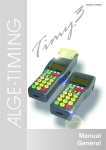

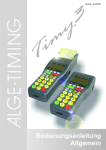
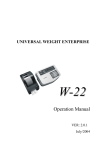
![[U4.81.01] Opérateur CALC_ELEM](http://vs1.manualzilla.com/store/data/006362647_2-87f5088f59fdefefd09a0a6fb54d74eb-150x150.png)
